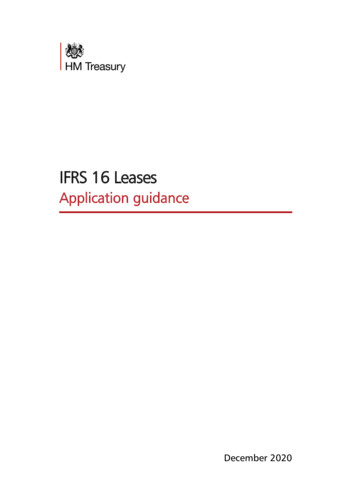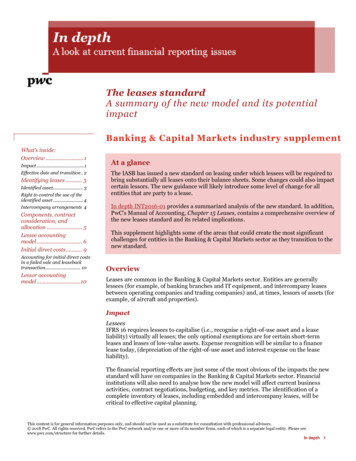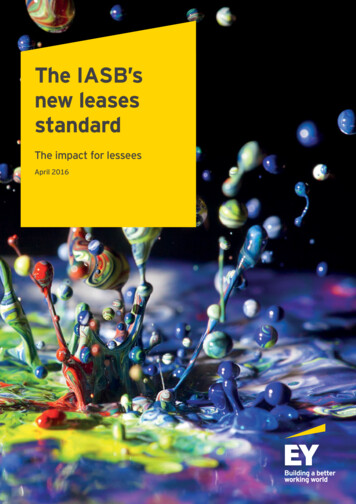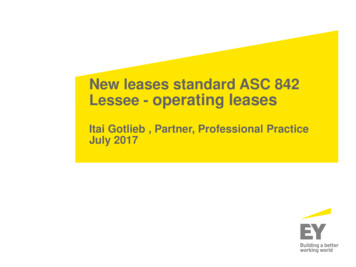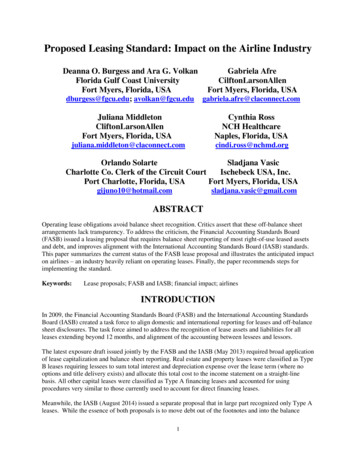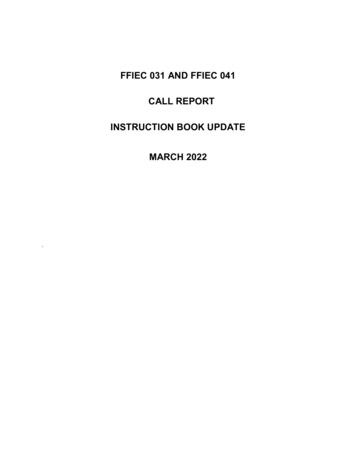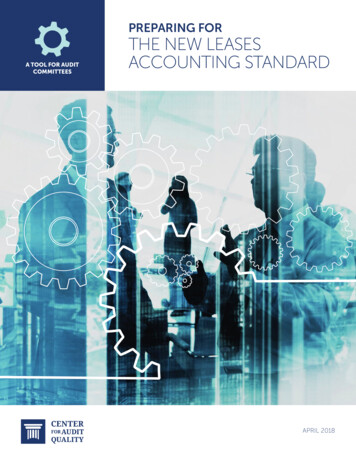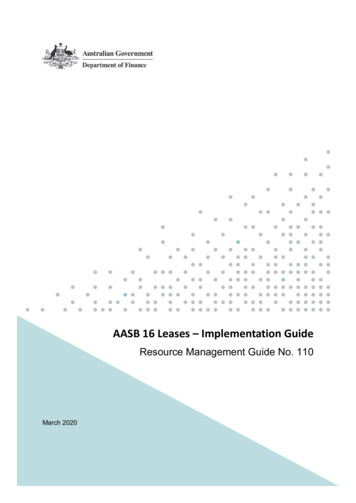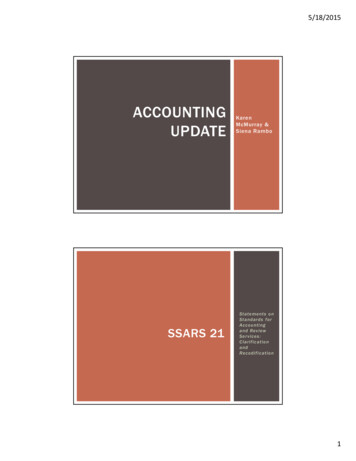
Transcription
Chapter 1Economics of Net Leasesand Sale-Leasebacks§ 1:1What Is a Net Lease?§ 1:2Types of Net Leases§ 1:2.1Bond Lease§ 1:2.2Absolute Net Lease§ 1:2.3Triple Net Lease§ 1:2.4Double Net Lease§ 1:2.5The Allocation of Capital Expenses and the Split IncentiveProblem§ 1:3Pricing and Valuation of Net Leased Properties§ 1:3.1Basic Formulas§ 1:3.2The Two Meanings of Capitalization Rate§ 1:3.3Discounted Cash Flow Model§ 1:3.4Determining the Market Capitalization Rate of Long-TermNet Leases—Background[A] Ground Leases§ 1:3.5Determining the Market Capitalization Rate of Long-TermNet Leases Using Comparable Sales§ 1:3.6Pricing of Properties with Short-Term Net Leases§ 1:4Sale-Leasebacks§ 1:4.1What Is a Sale-Leaseback?§ 1:4.2Sale-Leaseback As a Form of Financing§ 1:4.3Advantages of a Sale-Leaseback to the Seller-Tenant§ 1:4.4Disadvantages of a Sale-Leaseback§ 1:4.5Sale-Leaseback Pricing§ 1:5Volume of Net Lease Sales1–1
§ 1:1NET LEASES AND SALE-LEASEBACKS§ 1:1What Is a Net Lease?A net lease is a lease of property to a single tenant under whichthe tenant is responsible for substantially all of the expenses andobligations relating to the ownership, maintenance and use of theproperty during the term of the lease. In other words, in a net lease,the tenant retains substantially all of the exposure to the risks andcosts associated with the property, other than the risk of diminutionof the residual value of the property. The residual value of the property is the value of the property at the end of the lease term. Stateddifferently, in a net lease, the rent is “net” to the landlord.§ 1:2Types of Net LeasesIn most net leases, the landlord retains some exposure to the risksand costs relating to the property. Net leases are typically categorized based on the degree of exposure retained by the landlord. Thefollowing terms are often used to categorize net leases.§ 1:2.1Bond LeaseIn a bond lease, the landlord retains none of the exposure toproperty level costs or risks. Thus, the tenant under a bond leasemust pay rent during the term of the lease without exception. TheNational Association of Insurance Commissioners (NAIC) defines a“bond lease,” in part, as follows:A bond lease is a lease between a lessor and a lessee for a specified period of time with specified rent payments that are at leastsufficient to repay [lessor’s mortgage loan]. The bond leaserequires the lessee to perform all the obligations related to theleased premises. The investment community has historicallydefined a bond lease as a ‘hell or high water lease’, the generalconcept being that regardless of what occurs as to the leasedpremises, the lessee is obligated to continue to pay its rent.Therefore, [from the viewpoint of the lessor’s mortgage lender],the focus is on the credit of the lessee . . . not the real propertycharacteristics related to the premises.11.NAIC, Purposes and Procedures Manual of the NAIC InvestmentAnalysis Office (Dec. 31, 2015), pt. four, sec. 1(a)(ii)(A) (copy on filewith author). The NAIC Manual is available for purchase at http://www.naic.org/prod serv publications.htm.1–2
Economics of Net Leases and Sale-Leasebacks§ 1:2.2§ 1:2.5Absolute Net LeaseThe term “absolute net lease” has no legal or regulatory meaning,but is often used to describe a lease under which the tenant performsall obligations related to the leased premises and has no cancellation right except in the event of a condemnation having a materialadverse effect on tenant’s operations. In other words, an absolute netlease differs from a bond lease only in that an absolute net lease maybe terminated by the tenant following a material condemnation.§ 1:2.3Triple Net LeaseIn a triple net lease, the tenant is responsible for real estate taxes,utilities, and maintenance of the property. However, the tenant oftenhas the right to terminate the lease in the event of a casualty orcondemnation having a material adverse effect on the tenant’s operations. In addition, unless the tenant owned the property before thelease term commenced, the landlord may retain responsibility forenvironmental and other legal violations that predate the lease term.Finally, in some triple net leases, the landlord is required to pay forcapital improvements to the property.§ 1:2.4Double Net LeaseA double net lease differs from a triple net lease only in that thelandlord under a double net lease is responsible for the maintenanceof the roof and structure. Often in double net leases, the tenant willretain responsibility for maintenance of the roof membrane and roofing surface.§ 1:2.5The Allocation of Capital Expenses and theSplit Incentive ProblemA so-called “split incentive” occurs in a transaction where thebenefits do not accrue to the party who pays for the transaction. Splitincentives often interfere with rational investment decision making.2When the landlord is responsible for the payment of capital expenses(as is the case in double net leases and some triple net leases) and thetenant is responsible for the payment of utilities, a split incentive cuts2.See generally “Policy Options for the Split Incentive: Increasing EnergyEfficiency for Low-Income Renters,” 48 Energy Policy 506 (2012).1–3
§ 1:3NET LEASES AND SALE-LEASEBACKSagainst either party investing in capital improvements, such as solarpanels or energy efficient air conditioning, which could reduce utilityexpenses: the landlord has little incentive to pay for capital improvements to increase energy efficiency because it does not pay the utilitybills while the tenant, who pays the utility bills, has no right or obligation to make capital improvements that could reduce utility costs.3By contrast, when the tenant is responsible both for capital expensesand utility bills as is the case in absolute and bond net leases, incentives are properly aligned: the tenant has the right and responsibilityto select and pay for capital improvements that may reduce utilitybills and the tenant benefits directly from any such reduction.§ 1:3Pricing and Valuation of Net Leased Properties§ 1:3.1Basic FormulasAs is the case with other types of investment real estate, the priceof a net leased property is primarily a function of its capitalizationrate or “cap” rate. The capitalization rate of an investment propertyis defined by the following formula:Capitalization Rate Net Operating Income (NOI) PriceThus, generally:Price NOI Capitalization RateNOI, in turn, is calculated as follows:NOI Annual Rent – Landlord’s Share of Real Estate Taxes,Utilities, Insurance, and Maintenance ExpensesIn a net lease, the landlord’s share of real estate taxes, utilities,insurance and maintenance expenses is zero. As a result, during the3.Id. at 4–5.1–4
Economics of Net Leases and Sale-Leasebacks§ 1:3.3term of a net lease, NOI is equal to the annual rent. Accordingly, ina long-term net lease:And,Capitalization Rate Annual Rent PricePrice Annual Rent Capitalization RateConsequently, the price of a property subject to a long-term netlease is primarily a function of the annual rent and the capitalizationrate. The price is inversely related to the capitalization rate. Thus,prices rise as capitalization rates fall.§ 1:3.2The Two Meanings of Capitalization RateThe term “capitalization rate” is used in two different ways. First,as above, it is simply the actual annual rate of return on a particular investment property given the price paid (or asked) for the property and the property’s net operating income. We will refer to thecapitalization rate in this sense as the actual capitalization rate. Tocalculate the actual capitalization rate, both the price and the netoperating income must be known. Second, capitalization rate is usedas a measure of the riskiness of a property’s cash flows given suchfactors as the creditworthiness of the tenant and the location of theproperty. We will refer to the capitalization rate in this sense as themarket capitalization rate. The market capitalization rate is used tocalculate the value of an investment property given its net operatingincome. The market capitalization rate for a given property is generally calculated based on the actual capitalization rates of comparableproperties.§ 1:3.3Discounted Cash Flow ModelThe discounted cash flow model values an investment by discounting an investment’s future free cash flow projections to presentvalue based on actual or market weighted average cost of capital.Once the market capitalization rate (C) has been determined for agiven investment property and assuming a known constant annualnet operating income (NOI) for a period of n years, the value of aninvestment property may be calculated using the discounted cashflow model:1–5
§ 1:3.4NET LEASES AND SALE-LEASEBACKSProperty value present value of cash flows using the marketcapitalization rate as the discount rate NOI1 C NOI(1 C)2 . NOI(1 C)nWhere the cash flows are perpetual, this formula may be simplified by taking the limit of this formula as n approaches infinity. Asshown in detail in Appendix A, the simplified formula for the present value of a stream of perpetual cash flows is as follows:PV NOICOf course, this formula is the same as the formula derived fromthe actual capitalization rate shown above. A simple example willhelp to establish the soundness of the formula. Assume an investment has a 10% return rate and 100,000 in annual income. Thisincome divided by such return rate yields 1 million. If you invest 1 million, you could produce such an annual income in perpetuitygiven the 10% return rate.§ 1:3.4Determining the Market Capitalization Rate ofLong-Term Net Leases—BackgroundSince the annual rent under a net lease is typically a fixed, knownamount, pricing a net leased property involves a determination ofthe proper capitalization rate for the property. Capitalization rate isa measure of the risk associated with the return in question. In thecase of a long-term net lease (with the exception of certain groundleases),4 since substantially all property level risk is born by the tenant,the capitalization rate is primarily a function of the tenant’s financial strength. A property subject to a long-term net lease has similareconomics to a bond issued by the tenant under the net lease. This isespecially true when the lease is a bond lease and the rents are flat.However, there are two significant differences between an investor’s4.See infra section 1:3.4[A].1–6
Economics of Net Leases and Sale-Leasebacks§ 1:3.5economic position as the landlord under a net lease as opposed to theholder of a bond: first, upon expiration of the net lease, the landlordis exposed to both the upside potential of increased market rents andthe downside risk of decreased market rents and second, in the caseof a tenant bankruptcy, the tenant’s bondholders will have a claimin the tenant’s bankruptcy for the full amount of the bond while thetenant’s landlord will have a claim in the tenant’s bankruptcy thatis subject to the damage limitations of section 502(b)(6) of the U.S.Bankruptcy Code.5[A]Ground LeasesIn a ground lease, the tenant leases the land from the landlord andowns the improvements during the term of the lease. Ground leasestypically provide that upon termination of the term of the lease,ownership of the improvements reverts to the landlord. Even in theabsence of such provision, however, the termination of the groundlease effectively deprives the tenant of the benefit of the improvements as it cannot access them without committing a trespass. Asa result, assuming the ground rent under the ground lease approximates the fair market rent of the land (without the improvements),the landlord under the ground lease is in a very secure position: ifthe tenant fails to pay rent, the landlord can obtain ownership andpossession of the improvements and presumably a substantiallyhigher rent by simply terminating the lease and evicting the tenant.For this reason, a default by the ground tenant is very unlikely assuch default leads not only to loss of the leasehold but also to loss ofthe improvements. Accordingly, a property subject to such a groundlease will typically have a relatively low market capitalization rateregardless of the credit of the ground tenant.§ 1:3.5Determining the Market Capitalization Rate ofLong-Term Net Leases Using Comparable SalesBrokers calculate capitalization rates based on their knowledge ofcomparable sales. In the case of a long-term net lease, where thecapitalization rate is primarily a function of the tenant’s financialstrength, brokers typically look to a tenant’s credit rating. The majorrating agencies—sometimes referred to as the nationally recognized5.See infra section 3:1.3 for a discussion of this Bankruptcy Code section.1–7
§ 1:3.6NET LEASES AND SALE-LEASEBACKSstatistical rating organizations—are Standard & Poor’s Ratings Services, Moody’s Investors Service, Inc., and Fitch Ratings, Inc.6 As aresult, to determine the capitalization rate of a net leased propertybeing offered for sale, brokers look at the capitalization rate of properties leased to tenants with credit ratings comparable to that of thetenant of the property being sold. The higher the tenant’s credit rating, the lower the risk the tenant will default under the lease, andtherefore the lower the capitalization rate.§ 1:3.6Pricing of Properties with Short-Term NetLeasesA property subject to a short-term net lease is valued using thesame techniques applicable to multi-tenant properties with anadjustment for the existing short-term net lease. If the net leasehas fixed price renewal options, those options impose a ceiling onthe value of the property. The ceiling is equal to the value the prop erty would have assuming the tenant exercised in advance all of therenewal options.§ 1:4Sale-Leasebacks§ 1:4.1What Is a Sale-Leaseback?A sale-leaseback is the sale of a property from a seller to a buyerand the simultaneous lease of the property from the buyer back tothe seller. Since the seller is entitled to possession of the propertyduring the term of the lease, the net effect of a sale-leaseback is apromised stream of rental payments to the buyer plus the transferfrom the seller to the buyer of the residual interest of the property—that is, the right to the use of the property upon expiration of thelease term.§ 1:4.2Sale-Leaseback As a Form of FinancingCompanies that own their factories, retail outlets or other realestate facilities often find that the capital tied up in these assetswould yield a higher return if reinvested in their core businesses.Accordingly, many companies monetize their real estate assetsthrough various forms of asset-based financing. A sale-leaseback6.See infra section 2:2 for further discussion of credit ratings.1–8
Economics of Net Leases and Sale-Leasebacks§ 1:4.3involving a long-term lease is often viewed as a form of asset-basedfinancing, as the seller-tenant receives cash for the value of the property and retains possession of the property in return for periodic payments of rent to the buyer-landlord.§ 1:4.3Advantages of a Sale-Leaseback to theSeller-TenantFrom the standpoint of the seller-tenant, the real estate sale-leasebackoffers several advantages over conventional mortgage financing.First, the sale-leaseback should provide the company with cash equalto 100% of the fair market value of the property, while conventionalmortgage financing generally yields cash proceeds equal to 75% orless of the value of the property. Second, when long-term interestrates are low, a sale-leaseback may enable the company to lock in alow cost of funds for a longer term than is available to the companythrough conventional financing. Third, a company’s ability to obtaina mortgage loan may be limited or precluded by state or federal regulations or by financial covenants under its existing credit facilities.In such cases, a sale-leaseback may be the company’s only practicalmeans of raising capital without violating such restrictions. Finally,under current U.S. accounting rules, a properly structured saleleaseback provides the seller-tenant with favorable financial accounting treatment: the seller-tenant removes the real estate and relatedliabilities from its balance sheet and adds any profit from the sale toits income statement. By contrast, with conventional financing, theborrower does not sell the property so there is no gain to recognize.Although conventional financing generally offers a favorable meansof generating tax-free cash, with conventional financing the borrowermust show the financing as a liability on its balance sheet and mustrecord annual depreciation charges for the property’s improvementsas an expense on its income statement. As a result, an off-balancesheet sale-leaseback will improve the company’s reported earnings,return on assets and equity and debt-to-equity ratio as compared toconventional financing. Perhaps for these reasons, sale-leasebackshave been shown to produce a small, but statistically significant gainin the market value of the stock of the seller-tenant.77.See Marshall E. Tracht, Leasehold Recharacterization in Bankruptcy:A Review and Critique, The ACREL Papers (Fall 2012), n.12 and1–9
§ 1:4.4NET LEASES AND SALE-LEASEBACKS§ 1:4.4Disadvantages of a Sale-LeasebackSale-leasebacks also have drawbacks for the seller-tenant. First,the seller-tenant gives up the right to share in future appreciationof the property. Second, the seller-tenant is locking itself in to a leaseterm that may extend beyond the period for which the seller-tenantcan profitably use the property. Third, unless the seller-tenant is ableand willing to engage in a section 1031 exchange, the seller-tenantmay have to pay capital gains tax on its profit from the sale. Fourth,in certain states, a sale-leaseback triggers transfer taxes8 and reassessment for purposes of real property taxation.9§ 1:4.5Sale-Leaseback PricingAccording to a recent study, properties transferred in a sale-leasebacksold at a premium of about 13% as compared to non-sale-leasebackproperties.10 The study analyzed the data for 3,978 office, industrialand retail properties in seven U.S. cities sold from 1993 through 2007.When adjusted for property type, location, building age and size, andmarket condition (year), the study found that sale-leaseback properties sold for about 13% more than the equivalent non-sale-leasebackproperties. The study also found that this premium appeared to beexplained by the fact that net operating income was higher (and thus,capitalization rates were lower) for sale-leaseback properties as compared with non-sale-leaseback properties. According to the authors,there are two possible reasons for these differentials: (1) theexpected cash flows for a sale-leaseback property may be greaterbecause of the lack of anticipated periodic vacancy caused bytenant turnover typically observed in commercial property markets, and (2) the credit profile for sale-leaseback tenants may behigher and the history of the firm (lessee) at the property location may lead to lower risk.118.9.10.11.accompanying text, kruptcy.pdf.See infra section 5:7.2.See infra section 2:3.3[A][1].C.F. Sirmans & Barrett A. Slade, Sale-Leaseback Transactions: PricePremiums and Market Efficiency, 32 J. Real Est. Research 221 (2010).Id. at 238.1–10
Economics of Net Leases and Sale-Leasebacks§ 1:5§ 1:5Volume of Net Lease SalesAccording to a recent report by a leading U.S. real estate brokeragefirm, there were approximately 47.2 billion in sales of net leasedproperties in 2017 consisting of 20.3 billion in sales of net leasedoffice properties, 17.1 billion in sales of net leased industrial properties and 9.9 billion in sales of net leased retail properties.1212.Jones Lang LaSalle IP, Inc., “Net Lease Investment Outlook” (H2 2017).1–11
§ 1:4.4 Disadvantages of a Sale-Leaseback § 1:4.5 Sale-Leaseback Pricing § 1:5 Volume of Net Lease Sales Chapter 1 Economics of Net Leases . and Sale-Leasebacks § 1:1. N. ET . L. EASES AND. S. ALE-L. EASEBACKS. . A simple example will : help to establish the soundness of the formula. Assume an invest-ment has a 10% return rate and .
